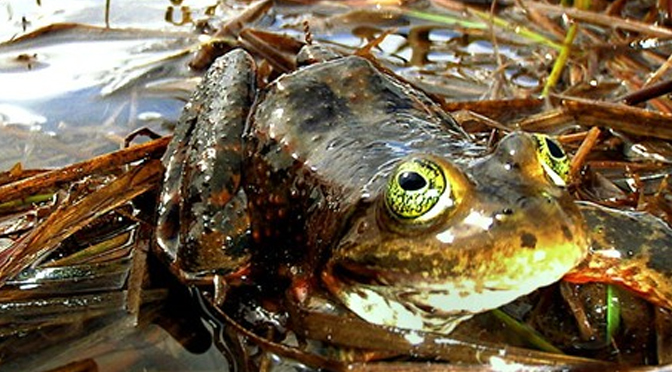Five central Oregon irrigation districts, the United States Bureau of Reclamation, and two environmental groups submitted to Judge Ann Aiken late last week a settlement agreement intended to resolve two lawsuits related to the Oregon spotted frog. The settlement represents a science-based effort to improve Oregon spotted frog habitat in the Deschutes Basin, avoid adverse impacts to other species, and protect the rights and livelihoods of central Oregon communities, family farmers, and ranchers. The settlement agreement will not go into effect unless it is approved by Judge Aiken.
WaterWatch of Oregon and the Center for Biological Diversity filed the lawsuits in late 2015 and early 2016, claiming that the operation of three reservoirs—Crane Prairie, Crescent, and Wickiup—harms the Oregon spotted frog, a species listed as “threatened” under the Endangered Species Act (ESA). The lawsuits created significant uncertainty for farm and ranch families, and those who rely on the irrigation districts for water supplies stored in these three reservoirs.
Earlier this year, Judge Aiken denied a request by the environmental groups to order immediate changes to reservoir operations. Those changes would have resulted in abrupt and severe restrictions on reservoir operations and disrupted water supplies to thousands of families throughout the Deschutes Basin. Judge Aiken also ordered the parties to participate in settlement discussions. Those discussions, which began on June 1, 2016, ultimately resulted in the settlement agreement submitted to the court today.
Under the settlement agreement, the irrigation districts would modify the operations of the reservoirs, with the goal of improving habitat for Oregon spotted frogs in and downstream from the reservoirs. The irrigation districts voluntarily implemented many of these changes over the past year, and would formally commit to them under the settlement. In addition to the already-implemented changes, the irrigation districts would ensure a minimum instream flow in the Upper Deschutes River of 100 cubic feet per second (cfs) between mid-September and the end of March—an increase compared to some years in which minimum instream flows during certain periods were closer to 20 cfs.
The Bureau of Reclamation would commit to using its best efforts to fulfill its obligations under the ESA related to the Oregon spotted frog by July 2017, including completing its consultation with the U.S. Fish and Wildlife Service regarding the potential effects of federal actions related to reservoir operations on the Oregon spotted frog. The Bureau of Reclamation initiated the consultation process in September 2015.
Under the settlement, in exchange for the commitments by the irrigation districts and the Bureau of Reclamation, the environmental groups’ lawsuits would be dismissed. And so long as the settlement is in effect, the groups would agree not to pursue the ESA claims raised in their complaints against the Bureau of Reclamation or the irrigation districts.
“The settlement agreement demonstrates that collaborative, science-based solutions can be achieved when all parties work together,” said Mike Britton, president of the Deschutes Basin Board of Control, which is made up of eight central Oregon irrigation districts, including those involved in the lawsuits. “This collaborative approach has proven successful in our region, and results in better outcomes than confrontation. The Deschutes Basin Board of Control would like to thank its local partners for their continued support and insights while the lawsuits were pending and as implementation of the settlement agreement moves forward.”
Although the settlement agreement is a step in the right direction, the irrigation districts recognize that it does not permanently resolve potential concerns related to the reservoirs’ impacts on the Oregon spotted frog or provide long-term liability protection to the districts. The irrigation districts and their partners remain committed to completing a multi-species habitat conservation plan (HCP), which represents a proactive, collaborative approach to balance fish and wildlife conservation with water use in the Deschutes Basin through innovative, science-based solutions. The HCP, once approved, will result in long-term benefits to the Oregon spotted frog, bull trout, steelhead, and other fish and wildlife species, the region’s water resources, and the social and economic health of communities. The HCP will also provide ESA-related liability protection to the districts.
About the DBBC
The Deschutes Basin Board of Control is made up of eight irrigation districts in Oregon’s Deschutes Basin. The districts supply water throughout the Deschutes Basin to 8,700 patrons across 155,662 acres. The districts work in partnership with conservation groups and local, state and federal agencies to increase instream flows in rivers and creeks, while improving fisheries passage and ecologically important habitat. Since 2000, the districts have increased instream flows by nearly 80,000 acre-feet in the Deschutes River, Little Deschutes River, Ochoco Creek, Whychus Creek, Tumalo Creek and Crescent Creek, benefitting salmon, steelhead, bull trout, Oregon spotted frog and other species. For more information on the irrigation districts and their conservation efforts, visit dbbcirrigation.com.





